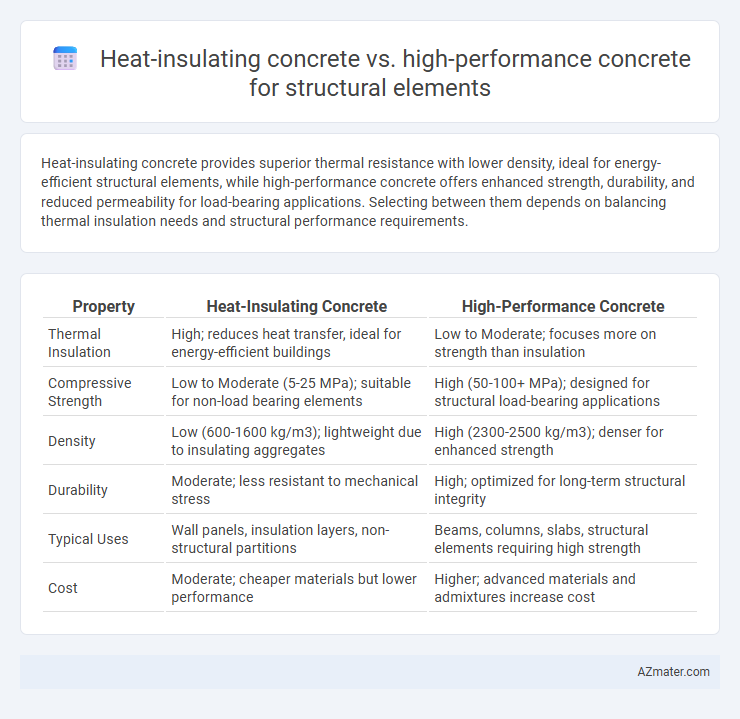Heat-insulating concrete provides superior thermal resistance with lower density, ideal for energy-efficient structural elements, while high-performance concrete offers enhanced strength, durability, and reduced permeability for load-bearing applications. Selecting between them depends on balancing thermal insulation needs and structural performance requirements.
Table of Comparison
| Property | Heat-Insulating Concrete | High-Performance Concrete |
|---|---|---|
| Thermal Insulation | High; reduces heat transfer, ideal for energy-efficient buildings | Low to Moderate; focuses more on strength than insulation |
| Compressive Strength | Low to Moderate (5-25 MPa); suitable for non-load bearing elements | High (50-100+ MPa); designed for structural load-bearing applications |
| Density | Low (600-1600 kg/m3); lightweight due to insulating aggregates | High (2300-2500 kg/m3); denser for enhanced strength |
| Durability | Moderate; less resistant to mechanical stress | High; optimized for long-term structural integrity |
| Typical Uses | Wall panels, insulation layers, non-structural partitions | Beams, columns, slabs, structural elements requiring high strength |
| Cost | Moderate; cheaper materials but lower performance | Higher; advanced materials and admixtures increase cost |
Introduction to Heat-Insulating and High-Performance Concrete
Heat-insulating concrete combines lightweight aggregates and insulating materials to reduce thermal conductivity, enhancing energy efficiency in structural elements. High-performance concrete features optimized mix designs with admixtures and fine aggregates to achieve superior strength, durability, and workability for demanding structural applications. These advanced concretes integrate specific properties to meet distinct performance criteria in modern construction projects.
Fundamental Properties and Composition
Heat-insulating concrete incorporates lightweight aggregates such as expanded polystyrene or perlite to achieve low thermal conductivity and enhanced insulation properties, while maintaining moderate compressive strength suitable for non-load-bearing structural elements. High-performance concrete (HPC) features a dense microstructure achieved through optimized cementitious materials like silica fume, fly ash, and superplasticizers, resulting in superior compressive strength exceeding 50 MPa, improved durability, and reduced permeability for critical load-bearing structures. Fundamental differences in composition directly affect thermal insulation capabilities and mechanical performance, guiding their application in structural elements based on specific performance requirements.
Thermal Insulation Capabilities
Heat-insulating concrete significantly reduces heat transfer in structural elements due to its low thermal conductivity, typically ranging between 0.1 to 0.3 W/m*K, enhancing energy efficiency in buildings. High-performance concrete (HPC), while characterized by superior compressive strength and durability, generally exhibits higher thermal conductivity values around 1.0 to 2.0 W/m*K, making it less effective for thermal insulation purposes. Incorporating materials like expanded perlite or vermiculite in heat-insulating concrete boosts its insulating capacity without compromising structural integrity, contrasting with HPC's focus on mechanical properties rather than thermal performance.
Mechanical Strength and Load-Bearing Capacity
Heat-insulating concrete typically exhibits lower mechanical strength and load-bearing capacity compared to high-performance concrete, due to its porous structure designed to enhance thermal insulation. High-performance concrete is engineered with optimized mix designs, including supplementary cementitious materials and chemical admixtures, resulting in superior compressive strength often exceeding 70 MPa and enhanced durability under structural loads. For critical structural elements requiring both high mechanical strength and load-bearing capacity, high-performance concrete is generally preferred over heat-insulating concrete.
Durability and Service Life
Heat-insulating concrete offers superior thermal resistance, reducing heat transfer and improving energy efficiency in structural elements, but generally exhibits lower compressive strength and durability compared to high-performance concrete. High-performance concrete is engineered for enhanced strength, durability, and resistance to environmental degradation, significantly extending the service life of structural components under aggressive conditions. Selecting high-performance concrete optimizes long-term structural integrity and minimizes maintenance costs, whereas heat-insulating concrete is preferred for applications requiring thermal insulation coupled with moderate structural demands.
Structural Applications and Suitability
Heat-insulating concrete offers superior thermal resistance, making it ideal for structural elements in buildings requiring energy efficiency and temperature regulation, such as walls and roof slabs. High-performance concrete provides enhanced mechanical strength, durability, and resistance to environmental stressors, making it suitable for load-bearing elements like beams, columns, and bridge decks. Structural applications demand heat-insulating concrete for thermal comfort and energy savings, while high-performance concrete excels in scenarios where structural integrity and longevity are critical.
Environmental Impact and Sustainability
Heat-insulating concrete reduces energy consumption in buildings by enhancing thermal efficiency through embedded insulating materials, significantly lowering heating and cooling demands and associated carbon emissions. High-performance concrete (HPC) offers superior strength and durability, enabling slimmer structural elements and reduced material use, which minimizes environmental footprint and resource extraction. Both materials contribute to sustainability, but heat-insulating concrete primarily targets operational energy savings, while HPC focuses on structural longevity and resource efficiency.
Cost Comparison and Economic Considerations
Heat-insulating concrete generally features lower thermal conductivity and enhanced energy savings but often comes with higher initial material costs compared to high-performance concrete, which is designed for superior strength and durability. High-performance concrete may reduce long-term maintenance expenses due to its enhanced structural properties, potentially offsetting its higher price in demanding environments. Economic considerations should include lifecycle cost analysis, balancing upfront investment against operational savings and expected service life for structural elements.
Construction Methods and Workability
Heat-insulating concrete features lower density and higher porosity, enhancing thermal resistance but reducing workability compared to high-performance concrete, which contains additives like superplasticizers to improve flow and compaction. Construction methods for heat-insulating concrete often require careful layering and curing to maintain insulation properties, while high-performance concrete allows for faster placement methods and can be pumped more easily due to its superior workability. Structural elements using heat-insulating concrete benefit from enhanced energy efficiency, whereas those with high-performance concrete achieve higher strength and durability with more efficient construction processes.
Choosing the Right Concrete for Structural Elements
Heat-insulating concrete offers enhanced thermal resistance, reducing energy consumption in buildings, while high-performance concrete provides superior strength, durability, and resistance to environmental stressors, making it ideal for load-bearing structural elements. Selecting the right concrete depends on project-specific requirements, balancing thermal performance with mechanical properties such as compressive strength, tensile strength, and modulus of elasticity. For structural elements exposed to extreme loads or environmental conditions, high-performance concrete ensures longevity and safety, whereas heat-insulating concrete is preferred where thermal efficiency and energy conservation are priorities.

Infographic: Heat-insulating concrete vs High-performance concrete for Structural element
 azmater.com
azmater.com